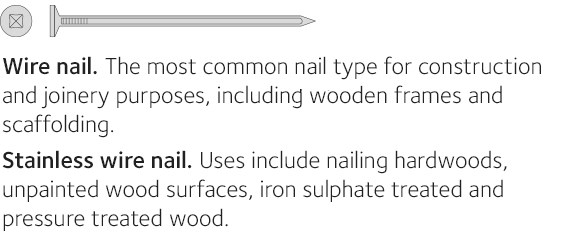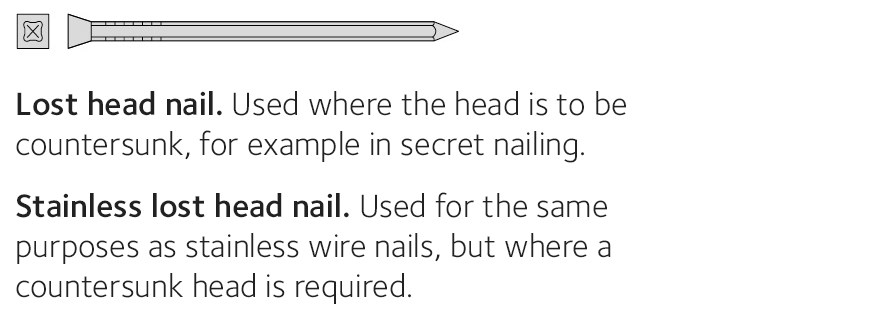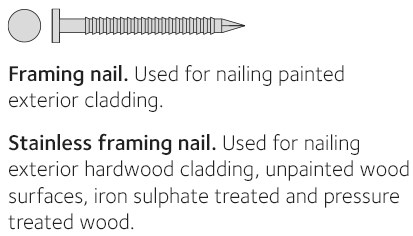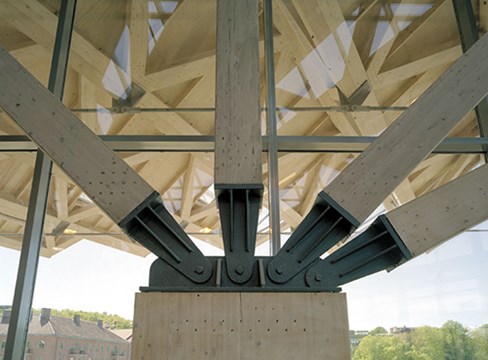Fasteners
This section provides a whole host of examples of nails and screws, a comparison between nailing and screwing, screw guides and detailed advice on choosing the right screw in wood construction.
Nails
Nailing is traditionally the most common way to connect wood in buildings. There are all sorts of different nail types and grades. Screwing has increased in recent years, and is used today to fit sheet material and in load-bearing structures. Structural fixings are used in combination with nails or screws and allow for the transfer of forces.
For outdoor use, nails, screws and structural fixings must be protected against corrosion or made from stainless steel.
Things to consider before nailing:
- Will the nails be exposed to moisture?
- What is the substrate?
- What materials are to be fixed in place?
- Will the surface be filled or painted?
- Risk of causing splitting.
Always use hot-dip galvanised round wire (framing) nails when fitting exterior cladding, unless otherwise stated. Stainless steel nails are used in particularly exposed locations and to nail hardwood exterior cladding, repainted wooden surfaces, and iron sulphate or pressure-treated wood. Pre-drilling may be needed when nailing in groups, close to end-grain wood and into hardwoods.
When nailing mouldings and suchlike that will also be filled and painted, brad nails should be used. Always use brad nails for secret nailing.
To avoid galvanic corrosion, sheet metal such as copper and aluminium should be fixed into place with nails or screws in the same base material, or stainless steel. Always use hot-dip galvanised nails outdoors and stainless steel nails and screws in particularly exposed locations.
Hot-dip galvanising of greater than or equal to 50 μm (micrometres) equates to corrosivity class C4. Stainless steel grade A2 equates to corrosivity class C4, while A4 equates to corrosivity class C5.
Screws
Screws come in various shapes and sizes designed specifically to fix particleboard, plasterboard, mouldings, exterior and interior cladding, decking, structural fixings and floorboards. Screws for load-bearing structures may have a metric machine bolt thread or a wood screw thread. Screws are used for large-scale structures and to secure structural fixings. Specialist fasteners such as through-bolts are used to assemble glulam and CLT structures.
Choice of screw
Thread
Threads designed specifically for wood. Screws for fixing panels or decking have an unthreaded section below the head equating to the thickness of the material being installed, in order to achieve a secure fix to the substrate. Full thread: (plasterboard).
Most common finish
Interior: electrogalvanised, phosphated, zinc yellow plated, white powder coated. Exterior: Finish corresponding to relevant corrosivity class with intended service life, hot-dip galvanised, stainless grade A2, A4 or A5.
Head
Conical head: often with ribs under the head to countersink the screw into wood/particleboard/plywood/MDF/HDF. Bugle: for interior plasterboard. Hexagonal head with internal drive, can be combined with a washer as required.
Screw drive
Slot, cross (Philips and Pozidrive), square, hex, torx.
Point
Screws with a custom drill point do not require pre-drilling.
Self-piercing point: for plasterboard and particleboard.
Fibre cut: used for hard materials such as particleboard.
Blunt: a nail point has a lower risk of splitting the wood than a threaded point.
Comparison between nailing and screwing
- Higher withdrawal forces with screws.
- Nails are softer than screws and can absorb small movements in the wood without it splitting.
- Disassembly is easier with screws.
- Avoid screwing or nailing closer than 100–150 mm from end-grain wood.
- If you do have to fix closer than 100–150 mm from end-grain wood:
- pre-drill when nailing.
- use self-drilling screws when screwing. - Nailing exterior cladding with a nail gun should be avoided, since the nails can easily go too far into the boards, allowing moisture to penetrate around the nail head. This is also the case for screws that are driven in too far.
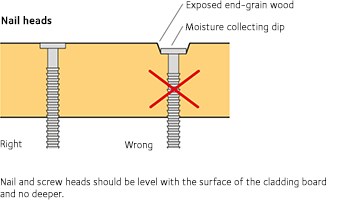
Fig. 108 Nail heads
Screw types, examples
Examples of screws, appearance may vary between suppliers.

 Bus stop, Vasaplan, Umeå.
Bus stop, Vasaplan, Umeå.
Examples of connections with universal screws
Used for both lighter and heavier structures, e.g. conservatories, carports, floor structures and hall frames. The unthreaded part of the universal screws should lie in the cross-section of the timber.
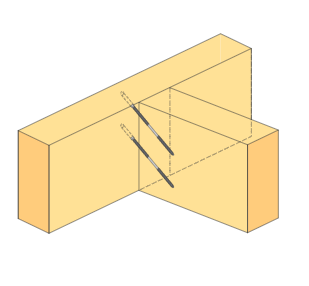
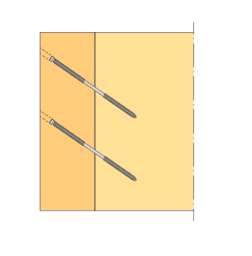
Primary–secondary beam
Connected with in-line, angled universal screws.
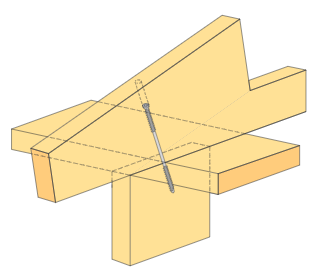
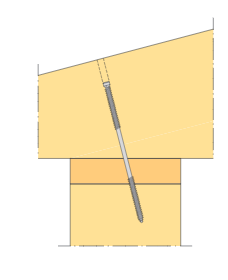
Roof truss
Connected with in-line universal screws.
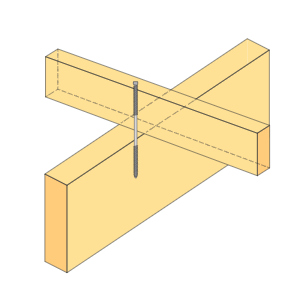
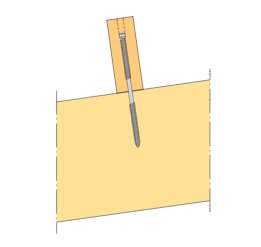
Purlin–rafter
Connected with in-line universal screws.
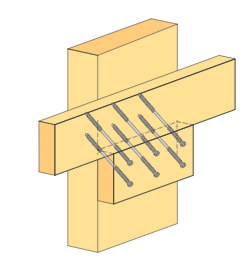
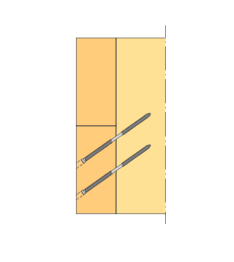
Cleat
Connected with in-line, angled universal screws.
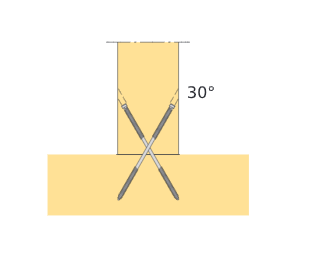
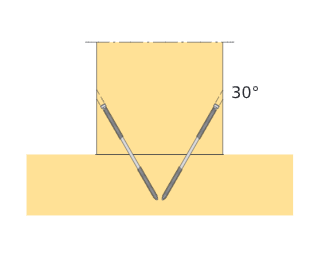
Studs–sill
Connected with crossed, angled universal screws.
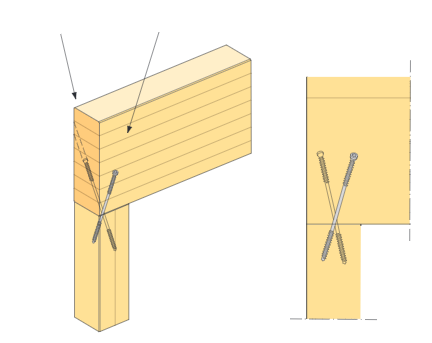
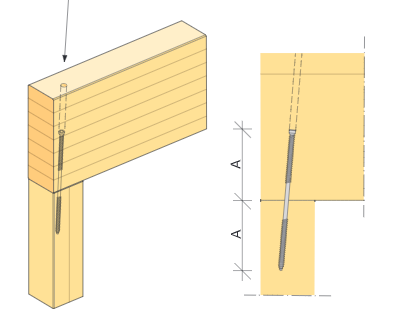
Glulam structures – post and beam
Connected with crossed, angled universal screws and in-line universal screws.
Choosing the right nail when building with wood
The table’s information is general. Nail finish, dimensions and so on may differ between manufacturers. Check the nail manufacturer’s instructions. In the event of contradictory information, the manufacturer’s instructions take precedence over table 41.
All dimensions are in mm unless otherwise specified.
Table 41 Nail guide
|
Thickness and material being nailed in wood frame (mm) |
Common finishes |
Nail type and dimensions (mm) |
Maximum centre spacing between nails (mm) |
Nails required (no./m2) |
Misc. |
|
|
Internal |
|
|
|
|
|
|
|
Floor: Floor joists approx. 600 |
|
|
|
|
|
|
|
22 |
Particleboard flooring |
Electrogalvanised 6) |
Ring-shank nail 2.8 × 60 |
Nail panels with max. 300 across body and max. 150 at joints along all stud-supported edges. 1) |
approx. 25 |
|
|
13 |
Plasterboard flooring |
Electrogalvanised 6) |
Jagged plasterboard nail 2.4 × 35 |
150 along edges and 200 in the middle of the plasterboard panel. 1) |
20–22 |
Nail row spacing max. 600. 1) |
|
14 |
Floorboard |
Hot-dip galvanised 7) |
Brad nail 2.0 × 50 |
400 |
approx. 25 |
Nail skewed at 45° angle on board’s tongue side. 2) |
|
20–22 |
Floorboard |
Hot-dip galvanised 7) |
Brad nail 2.3 × 60 |
600 |
approx. 15 |
Nail skewed at 45° angle on board’s tongue side. 2) |
|
25 |
Floorboard |
Hot-dip galvanised 7) |
Brad nail 2.3 × 60 |
600 |
approx. 15 |
Nail skewed at 45° angle on board’s tongue side. 2) |
|
30 |
Floorboard |
Hot-dip galvanised 7) |
Brad nail 2.8 × 75 |
600 |
approx. 15 |
Nail skewed at 45° angle on board’s tongue side. 2) |
|
Walls and roofs |
|
|
|
|
|
|
|
12–15 |
Interior cladding |
Hot-dip galvanised 7) |
Brad nail 1.7 × 40 |
600 |
approx. 17 |
Electrogalvanised nails will leave dirt deposits on cladding. |
|
21 |
Interior cladding |
Hot-dip galvanised 7) |
Brad nail 2.0 × 50 |
600 |
approx. 17 |
Electrogalvanised nails will leave dirt deposits on cladding. |
|
12 |
Mouldings |
Electrogalvanised 6), brass, zinc yellow plated, white powder coated |
Brad nail 1.4 × 30 |
400 |
approx. 3 per linear metre |
|
|
13 |
Normal plasterboard, 1 layer |
Electrogalvanised 6) |
Jagged plasterboard nail 2.4 × 35 |
150 along edges and 200 in the middle of the plasterboard panel. 1) |
20–22 |
Nail row spacing max. 450 for board width of 900 and max. 600 for board width of 1200. 1) |
|
13 |
Normal plasterboard, 2 layers |
Electrogalvanised 6) |
Jagged plasterboard nail 2.4 × 50 |
150 along edges and 200 in the middle of the plasterboard panel. 1) |
20–22 |
Nail row spacing max. 450 for board width of 900 and max. 600 for board width of 1,200. 1) |
|
11 |
OSB |
Electrogalvanised 6) |
Ring-shank nail 2.3 × 35 |
150 along edges and 300 in the middle of the panel. 1) |
20–22 |
Nail row spacing max. 600. 1) |
|
12 |
Particleboard/plywood |
Electrogalvanised 6) |
Brad nail jagged 2.0 × 35 |
100 along edges and 150–200 in the middle of the panel. 1) |
30–32 |
Nail row spacing max. 600. 1) |
|
19 |
Particleboard/plywood |
Electrogalvanised 6) |
Brad nail jagged 2.0 × 50 |
100 along edges and 150–200 in the middle of the panel. 1) |
30–32 |
Nail row spacing max. 600. 1) |
|
19 |
HDF/MDF |
Electrogalvanised 6) |
Brad nail jagged 2.0 × 40 |
75–100 along edges and 175–200 in the middle of the panel. 1) |
38–40 |
Nail row spacing max. 600. 1) |
|
22 |
Spaced boarding |
Hot-dip galvanised 7) |
Wire nail 2.8 × 75 |
400 3) |
7–11 |
2 nails at every support point. |
|
28 |
Spaced boarding |
Hot-dip galvanised 7) |
Wire nail 2.8 × 75 |
400 3) |
7–11 |
2 nails at every support point. |
|
External |
|
|
|
|
|
|
|
Terrace and fence |
|
|
|
|
|
|
|
22 |
Decking |
Stainless steel (A4) 8) |
Ring-shank nail 2.3 × 45 |
400 |
approx. 47/24 |
|
|
28 |
Decking |
Stainless steel (A4) 8) |
Ring-shank nail 2.5 × 60 |
600 |
approx. 35/17 |
|
|
34 |
Decking |
Stainless steel (A4) 8) |
Ring-shank nail 3.1 × 75 |
600–800 |
approx. 35/17 |
|
|
22 |
Picket |
Hot-dip galvanised 7), stainless steel (A4) 8) |
Wire nail 2.8 × 75 Framing nail 2.8 × 55 |
– |
approx. 20–58 per linear metre |
2 nails at every intersecting point. No. of nails based on 2 cross-studs. |
|
34 |
Cap rail/hand rail |
Stainless steel (A4) 8) |
Wire nail 2.8 × 100 Ring-shank nail 2.8 × 75 |
400 |
approx. 4 per linear metre |
|
|
Wall |
|
|
|
|
|
|
|
45 |
Studs |
Hot-dip galvanised 7) |
Wire nail 3.4 × 100 |
– |
approx. 6 per linear metre |
5) |
|
9 |
Exterior plasterboard |
Hot-dip galvanised 7) |
Clout nail 2.5 × 25 |
150 along edges and 200 in the middle of the plasterboard panel. 1) |
20–22 |
Nail row spacing max. 450 for board width of 900 and max. 600 for board width of 1,200. 1) |
|
28 |
Nailing batten for exterior cladding |
Hot-dip galvanised 7) |
Wire nail 2.8 × 75 |
600 |
approx. 9 |
2 nails at every intersecting point. 5) |
|
34 |
Nailing batten for exterior cladding |
Hot-dip galvanised 7) |
Wire nail 3.4 × 100 |
600 |
approx. 9 |
2 nails at every intersecting point. 5) |
|
22 |
Exterior cladding |
Hot-dip galvanised 7), stainless steel (A4) 8) |
Framing nail 2.8 × 48 |
– |
approx. 35 |
For nailing batten ≥ 28 |
|
Framing nail 2.8 × 55 |
For nailing batten ≥ 34 |
|||||
|
22 |
Board on board |
Hot-dip galvanised 7), stainless steel (A4) 8) |
Framing nail 2.8 × 70 |
– |
approx. 35 |
For nailing batten ≥ 28 |
|
Framing nail 2.8 × 75 |
For nailing batten ≥ 34 |
|||||
|
22 |
Cover batten |
Hot-dip galvanised 7), stainless steel (A4) 8) |
Framing nail 2.8 × 70 |
– |
approx. 15 |
For nailing batten ≥ 28 |
|
Framing nail 2.8 × 75 |
For nailing batten ≥ 34 |
|||||
|
22 |
Corner board |
Hot-dip galvanised 7), stainless steel (A4) 8) |
Framing nail 2.8 × 75 Brad nail 2.3 × 60 |
600, 150 |
approx. 3 per linear metre, approx. 8 per linear metre |
Fix to wall frame with framing nails. Nail corner boards with brad nails. |
|
22 |
Architrave |
Hot-dip galvanised 7), stainless steel (A4) 8) |
Framing nail 2.8 × 75 |
– |
approx. 30 |
|
|
Roof |
|
|
|
|
|
|
|
20 |
Sheathing |
Hot-dip galvanised 7) |
Wire nail 2.3 × 60 |
– |
15–20 |
4) |
|
23 |
Sheathing |
Hot-dip galvanised 7) |
Wire nail 2.8 × 75 |
– |
15–20 |
4) |
|
|
Roofing felt |
Hot-dip galvanised 7) |
Clout nail 2.8 × 20 |
– |
approx. 30 |
2) |
|
25 |
Counter batten |
Hot-dip galvanised 7) |
Wire nail 1.7 × 40 |
250 |
approx. 10 |
|
|
25 |
Batten |
Hot-dip galvanised 7) |
Wire nail 2.8 × 75 |
310–375 |
approx. 20 |
1 nail at every intersecting point. |
|
45 |
Self-supporting batten |
Hot-dip galvanised 7) |
Wire nail 3.4 × 100 |
310–375 |
approx. 20 |
2 nails at every support point. |
|
45 |
Ridge board |
Hot-dip galvanised 7) |
Wire nail 4.0 × 125 |
1,200 |
approx. 2 per linear metre |
2 nails in every roof truss. |
|
|
Lower and outer row of tiles |
Stainless steel (A4) 8) |
Wire nail 2.8 × 100 Ring-shank nail 2.8 × 75 |
– |
approx. 2 |
2) |
|
|
Ridge tile |
Stainless steel (A4) 8) |
Wire nail 3.4 × 100 |
– |
approx. 3 per linear metre |
2) |
|
22 |
Boarding of eaves |
Hot-dip galvanised 7), stainless steel (A4) 8) |
Framing nail 2.8 × 55 |
– |
15–20 |
|
|
22 |
Fascia board |
Stainless steel (A4) 8) |
Wire nail 2.3 × 60 Ring-shank nail 2.3 × 50 |
200 |
approx. 6 per linear metre |
|
|
22 |
Bargeboard |
Hot-dip galvanised |
Wire nail 2.8 × 75 |
150 |
approx. 8 per linear metre |
Nail in zigzag pattern. |
- According to the material manufacturer’s instructions (plasterboard, OSB, particleboard, etc). Different centre-spacing around edges and in middle rows. Any frame stabilising or fireproofing requirements may create the need for closer centre-spacing and possibly more layers of panels.
- According to the material manufacturer’s instructions (plasterboard, OSB, particleboard, etc).
- Centre-spacing may vary, so observe requirements concerning resistance to fire and to failure when stepped on.
Centre-spacing for spaced boarding as underlay for plasterboard in ceilings must not exceed 400 mm in damp or unheated rooms. - Sheathing 95 or wider should be double-nailed.
- Fix as set out in the drawing.
- Electrogalvanised = min. 5 µm (micrometres) outer layer. Electrogalvanised in line with SS-EN ISO 2081.
- Hot-dip galvanised = min. 50 µm (micrometres) outer layer, corresponding to corrosivity class C4. Hot-dip galvanising in line with SS-EN ISO 1461.
- Stainless austenitic steel A4 in line with SS-EN 10088-5.
Choosing the right wood screw when building with wood
The table’s information is general. Screw finish, dimensions and so on may differ between manufacturers. Check the screw manufacturer’s instructions. In the event of contradictory information, the manufacturer’s instructions take precedence over table 42.
All dimensions are in mm unless otherwise specified.
Table 42 Screw guide
|
Thickness and material being screwed in wood frame (mm) |
Common finishes 5) |
Min. length (mm) |
Maximum centre spacing between screws (mm) |
Screws required (no./m2) |
Misc. |
|
|
Internal |
|
|
|
|
|
|
|
Floor: Joists approx. 600 |
|
|
|
|
|
|
|
22 |
Particleboard flooring |
Electrogalvanised 6), phosphated 7) |
50 |
200 |
approx. 18 |
1) 2) |
|
13 |
Plasterboard flooring |
Electrogalvanised 6), phosphated 7) |
30 |
300 |
approx. 15 |
Bugle head 1) 2) |
|
14 |
Floorboard |
Electrogalvanised 6), phosphated 7) |
28 |
400 |
approx. 25 |
Specialist screw 1) |
|
20–22 |
Floorboard |
Electrogalvanised 6), phosphated 7) |
44 |
600 |
approx. 15 |
Specialist screw 1) |
|
25 |
Floorboard |
Electrogalvanised 6), phosphated 7) |
47 |
600 |
approx. 15 |
Bugle head 1) |
|
30 |
Floorboard |
Electrogalvanised 6), phosphated 7) |
62 |
600 |
approx. 15 |
Bugle head 1) |
|
Wall/ceiling |
|
|
|
|
|
|
|
12–15 |
Interior cladding |
Electrogalvanised 6), phosphated 7) |
30 |
600 |
approx. 17 |
1) |
|
21 |
Interior cladding |
Electrogalvanised 6), phosphated 7) |
40 |
600 |
approx. 17 |
1) |
|
12 |
Moulding/architrave |
Electrogalvanised 6), yellow or white power coated |
25 |
400 |
approx. 3 per metre |
1) |
|
13 |
Normal plasterboard, 1 layer |
Electrogalvanised 6), phosphated 7) |
30 |
3) |
18–20 |
Bugle head |
|
13 |
Hard plasterboard, 1 layer |
Electrogalvanised 6), phosphated 7) |
32 |
3) |
3) |
Bugle head 1) 4) |
|
12 |
Particleboard/plywood |
Electrogalvanised 6), phosphated 7) |
28 |
3) |
18–20 |
1) 2) |
|
12 |
HDF/MDF |
Electrogalvanised 6), phosphated 7) |
35 |
3) |
18–20 |
1) 2) |
|
12 |
Cement-bonded particleboard |
Electrogalvanised 6), phosphated 7) |
35 |
3) |
3) |
1) 2) |
|
19 |
Particleboard/plywood |
Electrogalvanised 6), phosphated 7) |
40 |
3) |
3) |
1) 2) |
|
19 |
HDF/MDF |
Electrogalvanised 6), phosphated 7) |
40 |
3) |
3) |
1) 2) |
|
External |
|
|
|
|
|
|
|
22 |
Decking |
8) |
40 |
400 |
approx. 47/24 |
1) 2) 5) |
|
28 |
Decking |
8) |
51 |
600 |
approx. 35/17 |
1) 2) 5) |
|
34 |
Decking |
8) |
70 |
600–800 |
approx. 35/17 |
1) 2) 5) |
|
22 |
Exterior cladding |
8) |
48 |
600 |
approx. 35 |
1) 5) |
|
22 |
Board on board/cover batten |
8) |
65 |
600 |
approx. 35/15 |
1) 5) |
|
28 |
Nailing batten |
8) |
55 |
600 |
approx. 15 |
1) 5) |
|
34 |
Nailing batten for exterior cladding |
8) |
70 |
600 |
approx. 15 |
1) 5) |
|
9 |
Exterior plasterboard |
8) |
30 |
3) |
18–20 |
Flat head |
- Partial thread. Smooth shank nearest the head, at least equal to thickness of material being screwed into.
- Ribs beneath head, cut out and countersink the wood screw more easily in hard materials.
- According to the screw manufacturer’s instructions. Different centre-spacing around edges and in middle rows.
- Any frame stabilising or fireproofing requirements may create the need for closer centre-spacing and possibly more layers of panels.
- Specialist screws for hard plasterboard.
- Corrosivity classes range from C1–CX, see tables 43, 44 and 45, page 141.
- Electrogalvanised = min. 5 µm (micrometres) outer layer.
- Phosphated = min. 48-hour salt spray test.
- Stainless steel (A4) for C4 or finishes type approved in C4 for normal outdoor climate (e.g. zinc/nickel).
Table 43 Indoor environments with corrosivity class
|
Indoors |
Environment’s corrosivity level |
Corrosivity class1) |
|
Heated buildings with clean air: offices, shops, schools, hotels etc |
Very low |
C1 |
|
Unheated buildings where condensation may occur: warehouses, storage rooms, sports halls, etc |
Low |
C2 |
|
Production facilities with high humidity and some air pollutants: food manufacturers, laundries, breweries, dairies, etc |
Medium |
C3 |
|
Chemical production facilities, swimming pools, coastal shipyards and boatyards, etc |
High |
C4 |
|
Buildings or areas with almost permanent condensation and high air pollution |
Very high |
C5 |
|
Industrial areas with extra-high humidity and aggressive atmosphere |
Extreme |
CX |
1)Corrosivity classes in line with SS-EN ISO 12944-2.
Table 44 Outdoor environments with corrosivity class
|
Outdoors |
Environment’s corrosivity level |
Corrosivity class1) |
|
– |
Very low |
C1 |
|
Atmosphere with low pollution. Rural areas |
Low |
C2 |
|
Urban and industrial atmospheres, moderate sulphur dioxide levels. Coastal areas with low salt levels |
Medium |
C3 |
|
Industrial and coastal areas with moderate salt levels |
High |
C4 |
|
Industrial areas with high humidity and aggressive atmosphere, plus coastal areas with high salt levels |
Very high |
C5 |
|
Marine areas with high salt levels and industrial areas with extreme humidity and aggressive atmosphere, plus tropical and subtropical environments |
Extreme |
CX |
1) Corrosivity classes in line with SS-EN ISO 12944-2.
Table 45 Materials and finishes for each corrosivity class
|
Fixing/fastener |
Material/finish |
Corrosivity class1) |
|
|
Indoors |
Outdoors |
||
|
Nails, wood screws, dowels, bolts with nut and washer, staples and structural fixings or nail plates |
Untreated |
C1 |
|
|
|
Electrogalvanised 2) 5–25 µm (micrometres) |
C2 |
|
|
|
Sendzimir galvanised 3) Z275 |
C2 |
|
|
|
Hot-dip galvanised 4) ≥ 45 µm (micrometres) |
C4 |
C4 |
|
|
Stainless steel A2 5) |
C4 |
C4 |
|
|
Stainless steel A4 6) |
C5 |
C5 |
|
|
Stainless steel A5 7) |
CX |
CX |
|
|
Specialist coating8) with thickness according to coating system in question |
C3–C4 |
C3–C4 |
- Corrosivity class in line with SS-EN ISO 12944-2.
- Electrogalvanised in line with SS-EN ISO 2081.
- Sendzimir galvanised in line with SS-EN 10346. Applies to structural fixings and nail plates.
- Hot-dip galvanised in line with SS-EN ISO 1461.
Surface treatment of nails for outdoor use should be hot-dip galvanising 50–55 µm in line with SS-EN ISO 1461, table 3. Some woods, such as western red cedar (Thuja plicata) must have fasteners in stainless steel grade A4. Fasteners in stainless steel grade A4 should be used when installing exterior, unpainted wooden façades. Hot-dip galvanised fasteners may cause zinc streaking if no paint is applied. Structural fixings with a thickness >5.0 mm should be hot-dip galvanised to ensure self-healing. - Stainless austenitic steel A2 in line with SS-EN 10088-5.
- Stainless austenitic steel A4 in line with SS-EN 10088-5.
- Stainless austenitic steel A5 in line with SS-EN 10088-5.
- Specialist coating with documentation of durability and expected service life from an accredited certification body.
When assessing the climatic effect on stainless steel fasteners, an alternative to the corrosivity classes can be found in SS-EN 1993-1-4 Appendix A, which specifies suitable types of steel for particularly challenging environments such as swimming pools and road tunnels.
When choosing corrosivity classes, the expected service life of the fastener must always be stated.

